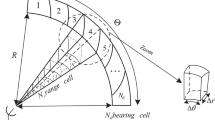Abstract
Mode S Second Surveillance Radar (SSR) is very important means for Air Traffic Control (ATC) now and future, all the responding data which the radar receives need parity processing. Bit and confidence declaration is an vital step before error detection and error correction. Based on the commonly used baseline multi-sample algorithm, different conditions are presented and analyzed, the conditions under which error happens are pointed out, and the algorithm in which two statistical variables are added to avoid false declaration. In addition, the moving average method is used to preprocess the sampled data, so as to reduce the influence of noise. The merits the baseline multi-sample technique owes are preserved, and the added computation is small. The declaration veracity is improved, and consequently makes error detection and error correction be facilitated successfully.
Similar content being viewed by others
References
N. Petrochilos, G. Galati, and E. Piracci. Array processing of SSR signals in the multilateration context, a decade survey. Tyrrhenian International Workshop on Digital Communications-Enhanced Surveillance of Aircraft and Vehicles, TIWDC/ESAV’ 2008, Island of Capri, Italy, Sept. 3–5, 2008, 1–5.
M. Caramia, E. G. Piracci, G. Galati, and S. Gelli. Networking of SSR Mode S and related clustering problems. Radar Conference, EuRAD’ 2008, Amsterdan, Netherlands, Oct. 30–31, 2008, 192–195.
M. C. Stevens. Secondary Surveillance Radar. London: Artech House, Inc, 1988, 1, 2.
T. V. Ramabadran and S. S. Gaitonde. A tutorial on CRC computations. IEEE Micro., 8(1988)4, 62–74.
ADS-B 1090 MOPS, Revision A, Appendix I Extended Squitter Enhanced Reception Techniques, 14, 15.
G. Galati, M. Gasbarra, and E. G. Piracci. Decoding techniques for SSR mode S signals in high traffic environment. 2005 European Microwave Conference, Paris, France, Oct. 4–6, 2005, Vol. 3, 383–386.
Chen Shiyi and Li Yubai. Error correction using cyclic redundancy check based on confidence declaration. Telecommunication Engineering, 47(2007)1, 175–178.
Li Yubai, Wu Chun, and Tian Bing. Real-time arithmetic for MSSR reply decoding and confidence bits. Journal of Electronics & Information Technology, 28(2006)6, 989–993 (in Chinese). 李玉柏, 伍春, 田斌. MSSR 应答代码提取与置信度标注的实时算法. 电子与信息学报, 28(2006)6, 989–993.
C. Kabakchiev and I. Garvanov. CFAR BI technique for secondary surveillance radar. Tyrrhenian International Workshop on Digital Communications-Enhanced Surveillance of Aircraft and Vehicles, TIWDC/ESAV’ 2008, Islang of Capri, Italy, Sept. 3–5 2008, 1–4.
Zhou Haomin. The Base of Signal Processing Techniques. Beijing, Beijing University of Aeronautics and Astronautics Press. Sept. 2001, 276–277.
Author information
Authors and Affiliations
Corresponding author
Additional information
Communication author: Zhou Hongping, born in 1975, female, senior engineer.
About this article
Cite this article
Zhou, H., Guo, L. Improvement on algorithm of confidence declaration of mode s second surveillance radar. J. Electron.(China) 27, 250–255 (2010). https://doi.org/10.1007/s11767-010-0329-1
Received:
Revised:
Published:
Issue Date:
DOI: https://doi.org/10.1007/s11767-010-0329-1




